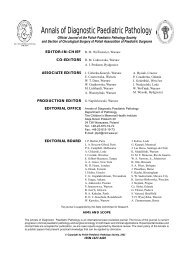tumor in the light of the revised SIOP-01 classification
tumor in the light of the revised SIOP-01 classification
tumor in the light of the revised SIOP-01 classification
You also want an ePaper? Increase the reach of your titles
YUMPU automatically turns print PDFs into web optimized ePapers that Google loves.
78<br />
Patients with persistent hypertension need chronic<br />
pharmaco<strong>the</strong>rapy based on α and β receptor antagonists. Calcium<br />
channel blockers also manage an effective blood pressure<br />
control without overshoot and orthostatic hypotension<br />
[2-5, 12, 28]. In case <strong>of</strong> <strong>in</strong>tolerance or resistance to α-blockers<br />
α-methylparatyros<strong>in</strong>e can be used to decrease <strong>tumor</strong> catecholam<strong>in</strong>e<br />
production [2, 28]. There are also some cl<strong>in</strong>ical<br />
experiences with unlabeled somatostat<strong>in</strong> analogues, but <strong>the</strong><br />
first results are not promis<strong>in</strong>g and no <strong>tumor</strong> regression or hormone<br />
level reduction were observed [28].<br />
Follow-up<br />
Long term, lifetime follow-up is necessary <strong>in</strong> all patients with<br />
pheochromocytoma because recurrent disease or distant metastases<br />
can develop even more than 15–20 years after successful<br />
resection <strong>of</strong> apparently benign primary <strong>tumor</strong> [6, 8,<br />
10, 12, 13, 27, 28]. Follow-up should <strong>in</strong>clude blood pressure<br />
References<br />
1. Averbach SD, Steakley CS, Young RN,<br />
et al (1988) Malignant pheochromocytoma:<br />
effective treatment with a comb<strong>in</strong>ation<br />
<strong>of</strong> cyclophosphamide, v<strong>in</strong>crist<strong>in</strong>e<br />
and dacarbaz<strong>in</strong>e. Ann Intern Med<br />
109: 267–273<br />
2. Bravo EL (1994) Evolv<strong>in</strong>g concepts <strong>in</strong><br />
<strong>the</strong> pathophysiology, diagnosis and treatment<br />
<strong>of</strong> pheochromocytoma. Endocr<br />
Rev 15: 356–368<br />
3. Bravo EL (2004) Pheochromocytoma:<br />
current perspectives <strong>in</strong> <strong>the</strong> pathogenesis,<br />
diagnosis and management. Arq<br />
Bras endocr<strong>in</strong>ol Metab 48: 746–750<br />
4. Bravo EL, Tagle R (2003) Pheochromocytoma:<br />
state-<strong>of</strong>-<strong>the</strong>-art and future<br />
prospects. Endocr Rev 24: 539–553<br />
5. Ciftci AO, Tanyel FC, Senocak ME,<br />
Buyukpamukcu N (20<strong>01</strong>) Pheochromocytoma<br />
<strong>in</strong> children. J Pediatr Surg 36:<br />
447–452<br />
6. Eisenh<strong>of</strong>er G, Bornste<strong>in</strong> SR, Brouwers<br />
FM, et al (2004) Malignant pheochromocytoma:<br />
current status and <strong>in</strong>itiatives<br />
for future progress. Endocr<strong>in</strong>e-Related<br />
Cancer 11: 423–436<br />
7. European Association <strong>of</strong> Nuclear Medic<strong>in</strong>e<br />
(2003) Guidel<strong>in</strong>es for 131 I–metaiodobenzylguanid<strong>in</strong>e<br />
<strong>the</strong>rapy. Eur J<br />
Nucl Med 30: BP23–BP26<br />
8. Fitzgerald PA, Goldfien A (2004) Adrenal<br />
Medulla. In: Greenspan FS, Gardner<br />
DG (Eds) Basic and cl<strong>in</strong>ical endocr<strong>in</strong>ology.<br />
Lange Medical Books/<br />
McGraw-Hill New York, pp 439–477<br />
9. Garaventa A, Gamb<strong>in</strong>i C, Villavecchia<br />
G, et al (2003) Second malignancies <strong>in</strong><br />
children with neuroblastoma after comb<strong>in</strong>ed<br />
treatment with 131 I-metaiodobenzylguanid<strong>in</strong>e.<br />
Cancer 97: 1332–1338<br />
10. Goldste<strong>in</strong> RE, O’Neill JA, Holcomb<br />
GW, et al (1999) Cl<strong>in</strong>ical experience<br />
over 48 years with pheochromocytoma.<br />
Ann Surg 229: 755–766<br />
11. Hoefnagel CA, Schornagel J, Valdes<br />
Olmos RA (1991) 131 I-metaiodobenzylguanid<strong>in</strong>e<br />
<strong>the</strong>rapy <strong>of</strong> malignant pheochromocytoma:<br />
<strong>in</strong>terference <strong>of</strong> medication.<br />
J Nucl Biol Med 35: 308–312<br />
12. Januszewicz W, Jarz¹b B, Januszewicz<br />
A, Prejbisz A (2005) Malignant pheochromocytoma.<br />
Arterial Hypertension<br />
9: 132–140 (<strong>in</strong> Polish)<br />
13. Januszewicz W, Prejbisz A, Januszewicz<br />
A, Pêczkowska M (2002) guz<br />
chromoch³onny-choroba o wielu obliczach.<br />
Arterial Hypertension 6:<br />
217–227 (<strong>in</strong> Polish)<br />
14. Januszewicz W, Wocial B, Chodakowska<br />
J et al. (1991) Z³oœliwy guz chromoch³onny.<br />
Pol Tyg Lek 48: 664–667<br />
(<strong>in</strong> Polish)<br />
15. Kaltas G, Mukherjee JJ, Plowman PN,<br />
Grossman AB (20<strong>01</strong>) The Role <strong>of</strong> chemo<strong>the</strong>rapy<br />
<strong>in</strong> <strong>the</strong> nonsurgical management<br />
<strong>of</strong> malignant neuroendocr<strong>in</strong>e tumours.<br />
Cl<strong>in</strong> Endocr<strong>in</strong>ol 55: 575–587<br />
16. Kaufman BH, Telander RL, van Heerden<br />
JA, Zimmerman D, Sheps SG,<br />
Dawson B (1983) Pheochromocytoma<br />
an <strong>the</strong> pediatric age group: current status.<br />
J Pediatr Surg 18: 879–884<br />
measurement, biochemical tests and imag<strong>in</strong>g studies. The first<br />
evaluation <strong>of</strong> plasma metanephr<strong>in</strong>e level or 24-hour ur<strong>in</strong>e collection<br />
for fractionated catecholam<strong>in</strong>es, metanephr<strong>in</strong>es is recommended<br />
approximately 2–6 weeks after <strong>the</strong> operation [8,<br />
22]. The next exam<strong>in</strong>ations should be obta<strong>in</strong>ed quarterly dur<strong>in</strong>g<br />
<strong>the</strong> first year after surgery and fur<strong>the</strong>r annually [6, 8]. Serum<br />
chromogran<strong>in</strong>-A can be also a good <strong>tumor</strong> marker, but<br />
only <strong>in</strong> patients with normal renal function [2, 4, 8]. Imag<strong>in</strong>g<br />
procedures <strong>in</strong>clud<strong>in</strong>g computed tomography (CT), magnetic<br />
resonance imag<strong>in</strong>g (MRI), 131 I or 123 I MIBG sc<strong>in</strong>tigraphy and<br />
new modalities such as somatostat<strong>in</strong> receptor sc<strong>in</strong>tigraphy or<br />
positron emission tomography (PET) should be performed on<br />
<strong>the</strong> basis <strong>of</strong> biochemical test f<strong>in</strong>d<strong>in</strong>gs [22].<br />
Conclud<strong>in</strong>g, successful treatment <strong>of</strong> malignant pheochromocytoma<br />
still rema<strong>in</strong>s a challenge for scientists and cl<strong>in</strong>icians.<br />
Fur<strong>the</strong>r <strong>in</strong>vestigations <strong>of</strong> genetic predispositions,<br />
new molecular prognostic markers and new <strong>the</strong>rapeutical approaches<br />
are required.<br />
17. Kon<strong>in</strong>gs JE, Brun<strong>in</strong>g PF, Abel<strong>in</strong>g NG,<br />
van Gennip AH, Hoefnagel CA (1990)<br />
Diagnosis and treatment <strong>of</strong> malignant<br />
pheochromocytoma with 131 I-metaiodobenzylguanid<strong>in</strong>e:<br />
a case report. Radio<strong>the</strong>rapy<br />
and Oncology 17: 103–108<br />
18. Lam MG, Lips CJ, Jager PL, et al<br />
(2005) Repeated 131 I-metaiodobenzylguanid<strong>in</strong>e<br />
<strong>the</strong>rapy <strong>in</strong> two patients with<br />
malignant pheochromocytoma. J Cl<strong>in</strong><br />
Endocr<strong>in</strong>ol Metab 90: 5888–5895<br />
19. Lio S, Napolitano G, Giuliani C, et al<br />
(1991) A overview on <strong>the</strong> management<br />
<strong>of</strong> malignant pheochromocytoma. J<br />
Nucl Biol Med 35: 263–265<br />
20. Mukherjee JJ, Kaltas GA, Islam N, et al<br />
(20<strong>01</strong>) Treatment <strong>of</strong> metastatic carc<strong>in</strong>oids<br />
tumours, pheochromocytoma, paraganglioma<br />
and nedullary thyroid carc<strong>in</strong>oma<br />
<strong>of</strong> <strong>the</strong> thyroid with 131 I-metaiodobenzylguanid<strong>in</strong>e.<br />
Cl<strong>in</strong> Endocr<strong>in</strong>ol 55:<br />
47–60<br />
21. Neumann DR, Bausch B, McWh<strong>in</strong>ney<br />
SR, et al (2002) Germ-l<strong>in</strong>e mutations <strong>in</strong><br />
nonsyndromic pheochromocytoma. N<br />
Engl J Med 346: 1459–466<br />
22. Pacak K, L<strong>in</strong>ehan WM, Eisenh<strong>of</strong>er G,<br />
Mc Clellan MW, Goldste<strong>in</strong> DS (20<strong>01</strong>)<br />
Recent Advances <strong>in</strong> genetics, diagnosis,<br />
localization and treatment <strong>of</strong> pheochromocytoma.<br />
Ann Intern Med 134:<br />
315–329<br />
23. Pham TH, Moir Ch, Thompson GB, et<br />
al (2006) Pheochromocytoma and paraganglioma<br />
<strong>in</strong> children: a review <strong>of</strong> medical<br />
surgical management at a tertiary<br />
care center. Pediatrics 118: 1109–1117

















